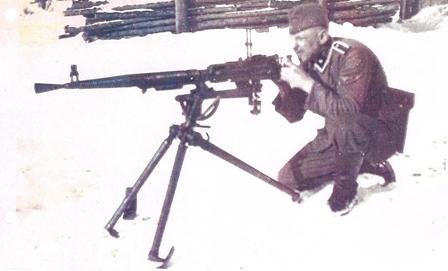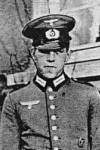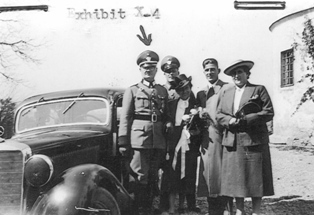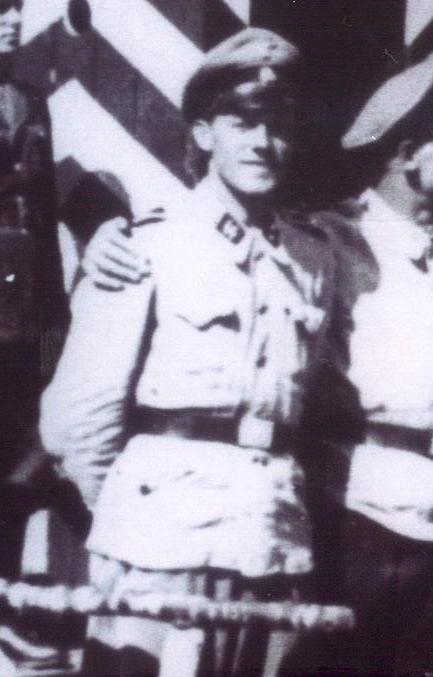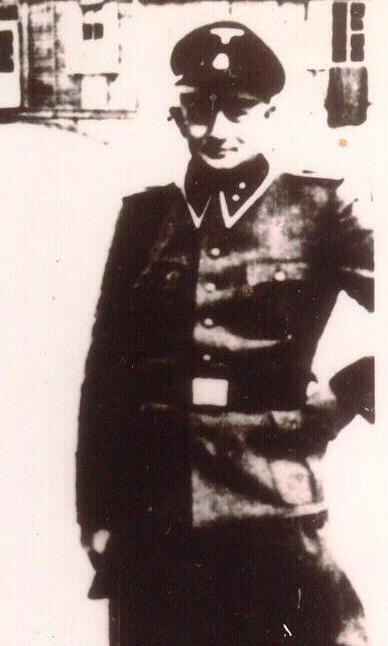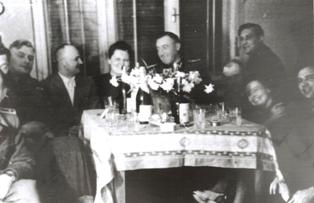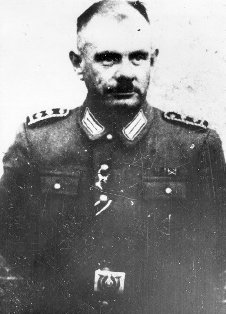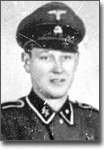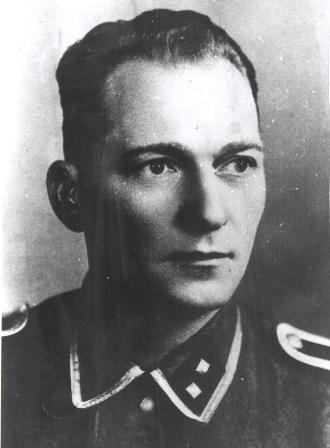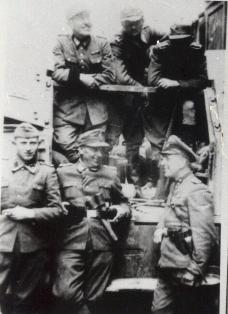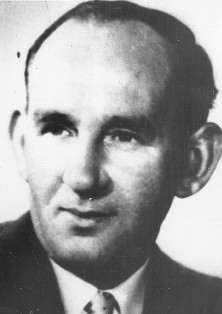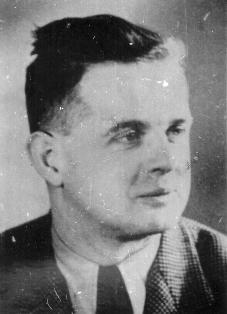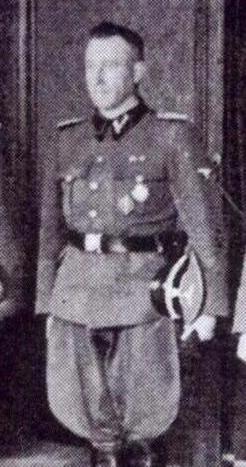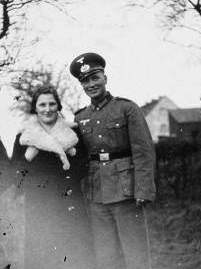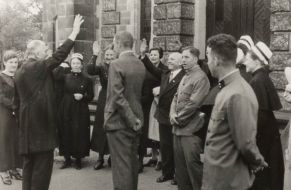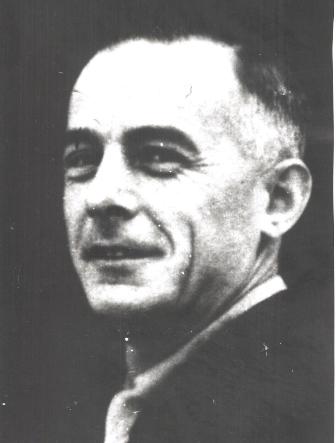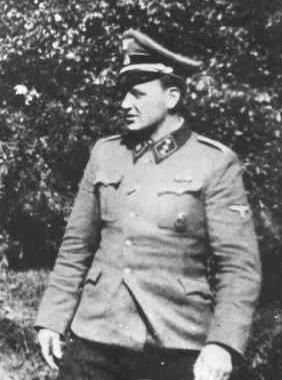Holocaust Education & Archive Research Team |
Aktion Reinhard
A-R Leadership A-R Articles
Action Erntefest Modern Research | ||||||||||||
Belzec, Sobibor & Treblinka Death Camps The Perpetrators Speak
Former Members of the SS-Sonderkommando Belzec describe their experiences in the Belzec death camp in their own words.
Erich Fuchs
Upon our arrival in Belzec, we met Friedel Schwarz and the other SS men, whose names I cannot remember. They supervised the construction of barracks that would serve as a gas chamber. Wirth told us that in Belzec “all the Jews will be struck down.”
For this purpose barracks were built as gas chambers, I installed shower heads in the gas chambers. The nozzles were not connected to any water pipes, they would serve as camouflage for the gas chamber.
For the Jews who were gassed it would seem as if they were being taken to baths and for disinfection.
Karl Alfred Schluch
In the morning or noon time we were informed by Wirth, Schwarz, or by Oberhauser that a transport with Jews should arrive soon. The disembarkation from the freight cars was carried out by a group of Jewish prisoners under the command of their Kapo’s. Two or three Germans from the camp staff supervised this action.
It was my obligation to carry out such supervision. After the disembarkation, the Jews were told that they had come here for transfer and they should go to bath and disinfection.
This announcement was made by Wirth and translated by a Jewish kapo. Afterwards the Jews were taken to the undressing barracks. My post in the “tube” was close to the undressing barrack. Wirth briefed me that while I was there I should influence the Jews to behave calmly. After leaving the undressing barracks, I had to show the Jews the way to the gas chambers.
I believe that when I showed the Jews the way they were convinced they were really going to the baths. After the Jews entered the gas chambers, the doors were closed by Hackenholt himself or by the Ukrainian subordinate to him.
Then Hackenholt switched on the engine which supplied the gas. After five or seven minutes – and this is only an estimate – someone looked through the small window into the gas chamber to verify whether all inside were dead.
Only then were the outside doors opened and the gas chambers ventilated. After the ventilation of the gas chambers, a Jewish working group under the command of their kapo’s entered and removed the bodies from the chambers.
Occasionally I had to supervise at this place, therefore I can describe the whole process which I saw and witnessed personally. The Jews inside the gas chambers were densely packed, this is the reason that the corpses were not lying on the floor but were mixed up in disorder in all directions, some of them kneeling, according to the amount of space they had.
The corpses were besmirched with mud and urine or with spit. I could see that the lips and tips of the noses were a bluish colour. Some of them had their eyes closed, others eyes rolled. The bodies were dragged out of the gas chambers and inspected by a dentist, who removed finger-rings and gold teeth. After this procedure, the corpses were thrown into a big pit.
Kurt Franz
I heard with my own ears how Wirth, in a quite convincing voice, explained to the Jews that they would be deported further and before that, for hygienic reasons, they must bathe themselves and their clothes would have to be disinfected.
Inside the undressing barrack was a counter for the deposit of valuables. It was made clear to the Jews that after the bath their valuables would be returned to them. I can still hear, until today, how the Jews applauded Wirth after his speech.
This behaviour of the Jews convinces me that the Jews believed Wirth.
Franz Stangl
Wirth was not in his office, they said he was up at the camp. I asked what was the matter? The man I was talking to said that one of the pits had overflowed. They had put too many corpses in it and putrefaction had progressed to fast so that the liquid underneath had pushed the bodies on top up and over, and the corpses had rolled down the hill.
I saw some of them – oh God it was awful.
Robert Juhrs
I had to carry out the shooting of Jews once. In that transport the cars were overloaded, some of the Jews were unable to walk. Maybe in that confusion, some of the Jews had been pushed down and had been crushed underfoot.
Therefore, there were Jews that, by no means, could cover the way to the undressing barrack. Gottlieb Hering gave me an order to shoot these Jews. He told me verbally, “Juhrs take these Jews to Camp ll immediately and shoot them there.”
These Jews were taken to the gate of Camp ll by a Jewish working group, and from there they were taken to the pits by other working Jews. As I remember there were seven Jews, men and women, who were taken inside the pit. It is hard to describe the condition these people were in, after their long journey in the unimaginably packed freight cars.
I regarded the killing of these people in this way as a mercy and redemption, I shot these Jews with a machine gun, as they stood on the edge of the pit, I aimed directly at their heads so that everyone died instantly. I am absolutely sure that nobody felt any torment.
Josef Oberhauser
After those first gassing operations, Wirth, Schwarz and all the German personnel disappeared from Belzec. As his final official act, Wirth had, before his departure gassed or shot the fifty working Jews, including their Kapos’s.
When Wirth and his people departed, I was in Lublin. I had a big transport of material to bring. When I came again to Belzec, nobody was there. In the camp there were about twenty Ukrainian guards. They were under the command of SS-Scarfuhrer Feiks.
Curiously enough, SS and Police Leader Globocnik had no knowledge of the departure of Wirth and his men. He sent me to Belzec to find out in which direction Wirth had gone. I found out that he had left for Berlin via Lvov and Cracow, without reporting to Globocnik.
Karl Schluch
I can relate that I saw the gas chambers in the euthanasia institutions and I was shown the gas chamber in Belzec. These were each about 4 x 8 meters. They had a friendly, bright appearance.
Whether the colour was yellow or gray, I don’t remember. Maybe the walls were painted with oil colours. In any case, the floor and part of the walls were made so that cleaning would be easy.
The newly arriving Jews must not guess the purpose the room served, and they should believe that it was a bath. Vaguely I remember that there were shower heads on the ceiling.
Heinrich Gley
From the beginning of August 1942 until the camp was closed in September 1943 I was in Belzec. As I remember, the gassing stopped at the end of 1942, when the snow was already falling.
Then the unearthing and cremation of the corpses began. It lasted from November 1942 until March 1943. The cremation was conducted day and night without interruption. At first the burning took place at one site, and later on at two.
One cremating site had the capacity to burn 2,000 corpses in twenty-four hours. About four weeks after the beginning of the cremation operation, the second burning site was erected.
On the average, during five months at the first about 300,000 corpses were cremated and in four months at the second burning site, about 240,000 corpses.
Naturally, these are average estimations.
Heinrich Unverhau
SS – Sturmbannfuhrer Hering accused me of being a saboteur because of the fact that during the sorting of the clothes that were sent for utilisation in Germany, a yellow Jewish star was found. Some money was also found there.
These clothes belonged to Jews who were killed in Belzec.
Heinrich Gley
I was assigned with a big Jewish work brigade to the cremation of the corpses by means of railway lines which served as a grate. About 80-90 Jews then worked under my supervision in three shifts.
The rails were placed on top of big rocks and narrow gauge rails served as a cross-mesh. The cremation surface could take about 200 corpses. First a wood fire was kindled under the iron grate.
During the course of the cremation operation the corpses later served as the only fuel. From time to time the badly twisted rails had to be replaced by new ones.
Werner Dubois
The transports to Belzec and, consequently the gassing operations, stopped quite suddenly. As staff members of the Belzec camp, we were informed that the place would be rebuilt completely. A working group of Jews, whose size I don’t remember, was in charge of the demolition work.
It is worth mentioning that at that time March – April 1943 the cremation of the corpses was terminated and the graves were levelled. The camp was emptied entirely and levelled accordingly. I heard that some planting was done there. The Jewish work commando, after accomplishing this work, was taken to Sobibor. I remained in Belzec for two more days, together with some of my colleagues and guards, to carry out the last clearing and loading.
Some time later, when I was in Sobibor, I heard that during the transport of the Jewish work commando from Belzec to Sobibor some mutiny and shooting took place which led to some deaths.
Heinrich Unverhau
A few weeks before the uprising in Sobibor I and three other SS men and a larger group of Ukrainians auxiliaries were again ordered to go to Belzec. We were doing forestation work there.
We had to prevent the Poles from turning the whole area upside down in their searches for gold.
Former Members of the SS-Sonderkommando Sobibor describe their experiences in the Sobibor death camp in their own words.
Franz Stangl
Wirth told me that I should definitely become the commander of Sobibor. I answered that I was not qualified for such a mission. I received from Globocnik the task to erect the camp. That it was not to be an ammunition camp but a camp for killing Jews I learned finally from Wirth.
During the discussion with Wirth he told me if I would not do it, another would come. He would then put me back at the disposal of the Brigadefuhrer Globocnik. Actually I was not relieved of my post.
I stayed in Sobibor, transports arrived and were liquidated.
Erich Fuchs
As ordered by Wirth I drove an LKW to Lvov, fetched a gas motor and transported it to Sobibor. When I arrived at Sobibor, close to the railway station I saw a tract of land with a concrete construction and some other solid buildings.
The Sonderkommando there were commanded by Thomalla. Other members of the SS who attended were F.B. Stangl, F.Schwartz, Kurt Bolender and others. We unloaded the motor. It was a heavy Russian benzine engine – presumably a tank or tractor motor at least 200 horsepower V-motor, 8 cylinders, water cooled.
We installed the engine on a concrete foundation and set up the connection between the exhaust and the tube. I then tested the motor. It did not work. I was able to repair the ignition and the valves, and the motor finally started running.
The chemist whom I knew from Belzec, entered the gas chamber with measuring instruments to test the concentration of the gas. Following this a gassing experiment was carried out.
If my memory serves me right, about thirty to forty women were gassed in one gas chamber. The Jewish women were forced to undress in an open place close to the gas chamber, and were driven into the gas chamber by the above mentioned SS members and by Ukrainian auxiliaries.
When the women were shut up in the gas chamber I and Bolender set the motor in motion. The motor functioned first in neutral. Both of us stood by the motor and switched from neutral to Cell, so that the gas was conveyed to the chamber.
At the suggestion of the chemist I fixed the motor on a definitive speed so that it was unnecessary henceforth to press on the gas. About ten minutes later the thirty to forty women were dead. The chemist and the SS Leader gave the sign to stop the motor. I packed my tools and saw how the corpses were removed. The transportation was done with a lorry trail that led from the gas chambers to a remote plot.
Erich Bauer
Normally, inside the camp, each member of the permanent staff had a specific function for example, commander of the Ukrainian auxiliaries, leader of a working group, excavation of pits, erection of barbed wire fences.
However, when a transport with Jews arrived there was so much “work” that the regular activity was interrupted, and everyone on the permanent staff had to participate somehow in the routine extermination process.
Primarily each member, of the permanent staff took place in the unloading of the transports.
Kurt Bolender
Before the Jews undressed Oberscharfuhrer Hermann Michel deputy commander of the camp made a speech to them. On these occasions, he used to wear a white coat to give the impression that he was a physician.
Michel announced to the Jews that they would be sent to work. But before this they would have to take baths and undergo disinfection so as to prevent the spread of diseases.
After undressing, the Jews were taken through the so-called Schlauch. They were led to the gas chambers, not by the Germans, but by Ukrainians. After the Jews entered the gas chambers, the Ukrainians closed the doors.
The motor which supplied the gas was switched on by a Ukrainian called Emil and by a German driver called Erich Bauer from Berlin. After the gassing, the doors were opened and the corpses were removed by a group of Jewish workers.
Hans – Heinz Schutt
Getting the detainees into the gas-chambers did not always proceed smoothly. The detainees would shout and weep and they often refused to get inside. The guards helped them on by violence.
These guards were Ukrainian volunteers who were under the authority of members of the SS commando. Members of the SS held key positions in the camp, i.e. one SS man oversaw the unloading, a further SS man was responsible for leading the detainees into the reception camp, a further SS man was responsible for leading the detainees to the undressing area, a further SS man oversaw the confiscation of valuables and a further member of the commando had to drive the detainees into the so-called tube which led to the extermination camp.
Once they were inside the so-called tube, which led from the hut to the extermination camp there was no longer any escape.
Erich Bauer
Usually the undressing went smoothly. Subsequently, the Jews were taken through the “tube” to Camp lll – the real extermination camp. The transfer through the “tube” proceeded as follows:
One SS man was in the lead and five or six Ukrainian auxiliaries were at the back hastening the Jews along. The women were taken through a barrack where their hair was cut off.
In Camp lll the Jews were received by SS men. As I already mentioned, the motor was then switched on by Gottinger and one of the Ukrainian auxiliaries whose name I don’t remember. Then the gassed Jews were taken out.
I was blamed for being responsible for the death of the Jewish girls Ruth and Gisela who lived in the so-called forester house. As it is known, these two girls lived in the forester house, and they were visited frequently by the SS men.
Orgies were conducted there. They were attended by Bolender, Hubert Gomerski, Karl Ludwig, Franz Stangl, Gustav Wagner and Steubel. I lived in the room above them and due to these celebrations could not fall asleep after coming back from a journey.
One evening Karl Ludwig banged on the girl’s door. Evidently he wanted to enter. The girls opened the door in my presence. Ludwig ordered the girls to put on their dressing gowns, and both of us took them in the direction of Camp lll.
I went half way only and then returned. Ludwig went with them alone. Next day Ludwig told me that by his order a Ukrainian had shot the two girls.
Erwin Herman Lambert
As I mentioned at the beginning, I was in the extermination camp of Jews for about two to three weeks. It was sometime in autumn 1942, but I don’t remember exactly when. At that time I was assigned by Wirth to enlarge the gassing structure according to the model of Treblinka.
I went to Sobibor together with Lorenz Hackenholt, who was at that time in Treblinka. First of all, I went with Hackenholt to a sawmill near Warsaw. There Hackenholt ordered a big consignment of wood for reconstruction in Sobibor.
Finally, both of us went to Sobibor. We reported there to the camp commander, Reichleitner. He gave us the exact directives for the construction of the gassing installation. Probably the old installation was not big enough, and reconstruction was necessary.
Today I cannot tell exactly who participated in the reconstruction work. However, I do remember that Jewish prisoners and so-called Askaries (Ukrainian auxiliaries) took part in the work.
During this time that building was in progress, no transports with Jews arrived.
Erich Bauer
Part of the trolleys and rails originated from the sawmill that bordered the Sobibor camp. Additional trolleys and rails arrived by train from Trawniki. The locomotive of this train came later, about two months after the trolley was in operation.
At the beginning horses pulled the trolleys. As I explained in previous interrogations, the trolley was laid to transport the sick and handicapped Jews from the arriving trains to Camp lll.
I know that these people, including the handicapped and sick children, and particularly infants, were taken to the so-called Lazarett, and there they were shot by those serving in Camp lll.
It was known in the camps, that the Lazarett was used not for healing but for the extermination of the people.
Hubert Gomerski
I remember the visit of Reichsfuhrer Heinrich Himmler in Sobibor. All the SS men, members of the police, and the Ukrainian volunteers were lined up in a parade. I personally reported my platoon to Himmler for inspection.
I know that on the day when Himmler was in Sobibor a certain number of Jews was gassed. I can tell for sure that Himmler visited Camp lll – extermination area. I saw Himmler with the whole group going in the direction of Camp lll.
Karl Frenzel
After the disembarking of the train, the children and the feeble Jews were forcibly thrown onto the trolley. Terrible scenes happened then. The people were separated from their families, pushed with rifle butts, lashed with whips. They cried dreadfully, so I could not cope with this task.
Reichleitner complied with my request, and he appointed Paul Bredow to escort the trolley.
Erich Bauer
Bolender was in charge of Camp lll. In Sobibor there was a working Jew whom Bolender ordered to box with another working Jew, and for his pleasure they hit each other almost until death.
Bolender had a big dog and when he was in charge of the platform workers he set the dog at the Jews, who did not work quickly enough.
Karl Frenzel
During my year and a half stay in Sobibor, I frequently saw that the working Jews were whipped. The Jews had to bow down and the Unterfuhrers (SS-men) ordered the Jewish kapos to whip them.
Usually they received between ten and twenty-five lashes. The working Jews attended the punishments in order to maintain camp discipline and as a deterrent. In most cases the Jews who were whipped were dressed.
Erich Bauer
I estimate that the number of Jews gassed at Sobibor was about 350,000. in the canteen at Sobibor I once overheard a conversation between Frenzel, Stangl and Wagner. They were discussing the number of victims in the extermination camps of Belzec, Treblinka and Sobibor and expressed their regret that Sobibor “came last” in the competition.
Werner Dubois
For about three weeks I was a leader of a Jewish group which worked outside the camp. I can remember the following event. During the time of my command, a Ukrainian guardsman was killed by two Jews when they want to bring water at a distance of 400-500 meters from the working place.
These two Jews escaped. When I saw that the water-bearers did not return for a long time, I sent another guardsman to see what was going on. He returned and reported to me that he had found the guardsman dead – and no sign of the two Jews.
After that I ordered all the Jews to lie on the ground to prevent further incidents. I sent a guardsman to the camp to inform camp commander Reichleitner what had happened.
On the day of the uprising, in the afternoon I was in the armoury together with some Ukrainian guardsmen. The door was open I saw a group of Jewish prisoners with axes approaching the armoury.
I thought that this was an ordinary working group. This group of five or six men passed by the armoury. They went round the armoury, crashed into the room, and hit me with axes. My skull was fractured, with an axe.
Other axe blows wounded my hands. In spite of it, I succeeded in extricating myself and escaping outside the armoury. After running about 10 meters, I was shot in the lung and lost consciousness.
Some Ukrainian guards treated me with vodka and I returned to consciousness. Then I learned that an uprising had broken out.
Franz Wulf
I went into the garden between Camp l and Camp ll On the way back with the Jewish women, I suddenly heard shots. I ran to the office which was in the forester’s house. I found Beckman and another member of the permanent staff there – both had been shot.
I ran back to Camp ll to the sorting barrack to find my brother. Later when the shooting stopped, I ran to the guard in the Forward Camp. There were more dead and Werner Dubois, who was badly wounded.
Former Members of the SS-Sonderkommando Treblinka describe their experiences in the Treblinka death camp in their own words.
Erwin Herman Lambert
I and Hengst – euthanasia man – went to Treblinka by car. SS-Hauptsturmfuhrer Richard Thomalla was the camp commander. The Treblinka camp was still in the process of construction.
I was attached to a building team there. Thomalla was there for a limited time only and conducted the construction work of the extermination camp. During this time no extermination actions were carried out.
Thomalla was in Treblinka for about four to eight weeks. Then Dr Eberl arrived as camp commander. Under his direction the extermination Aktionen of the Jews began.
Wili Mentz
When I came to Treblinka the camp commandant was a doctor named Eberl. He was very ambitious. It was said that he ordered more transports that could be “processed” in the camp.
That meant that trains had to wait outside the camp because the occupants of the previous transport had not yet all been killed. At the time it was very hot and as a result of the long wait inside the transport trains in the intense heat many people died.
At that time whole mountains of bodies lay on the platform. Then Hauptsturmfuhrer Christian Wirth came to Treblinka and kicked up a terrific row. And then one day Dr Eberl was no longer there.
For about two months I worked in the upper section of the camp and then after Eberl had gone, everything in the camp was re-organised. The two parts of the camp were separated by barbed-wire fences. Pine branches were used so that you could not see through the fences.
The same thing was done along the route from the “transfer” area to the gas chambers. The work-Jews who worked in the upper part of the camp also lived there from then on. Finally, new and larger gas-chambers were built. I think that there were now five or six large gas-chambers. I cannot say exactly how many people these large gas chambers held. If the small gas-chambers could hold 80-100 people, the large ones could probably hold twice that number.
I was then transferred to the so-called Lazarett area. This so-called Lazarett (field –hospital) was in the lower camp in a special zone which was fenced off and protected against onlookers by pine branches. In this area there was a large mass grave. This grave was dug by an excavator and must have been about seven meters deep.
Next to the mass grave there was a small wooden hut which was used by the two members of the Jewish Arbeitskommando who were on duty in the “Lazarett.”
These Jews wore armbands marked with a red cross. That was Kuttner’s idea – he was responsible for the lower camp. Following the arrival of a transport, six to eight cars would be shunted into the camp, coming to a halt at the platform there.
The commandant, his deputy Franz, Kuttner and Stadie or Matzig would be there waiting as the transport came in. Further SS members were also present to supervise the unloading, for example Genz and Belitz had to make absolutely sure that there was no one left in the car after the occupants had been ordered to get out.
When the Jews had got off Stadie or Matzig would have a short word with them. They were told something to the effect that they were a resettlement transport, that they would be given a bath and that they would receive new clothes. They were also instructed to maintain quiet and discipline. They would continue their journey the following day.
Then the transports were taken off to the so-called “transfer” area, the women had to undress in huts and the men out in the open. The women were then led through a passageway, known as the “tube,” to the gas chambers.
On the way they had to pass a hut where they had to hand in their jewellery and valuables, the shed was manned by two work-Jews and a member of the SS. The SS member was Suchomel.
After they had undressed the men had to put their and the women’s clothes in an orderly pile in a designated place. That only happened in the early days after the re-organisation. Later on there were special Arbeitskommandos which would immediately sort the clothes the transport participants had taken off.
There were always some ill and frail persons on the transports, sometimes there were also wounded people amongst the arrivals because the transport escorts, SS members, police, Latvians, sometimes shot people during the journey.
These ill, frail and wounded people were brought to the Lazarett by a special Arbeitskommando. These people would be taken to the hospital area and stood or laid down at the edge of the grave. When no more ill or wounded were expected it was my job to shoot these people.
I did this by shooting them in the neck with a 9-mm pistol, they then collapsed or fell to one side and were carried down into the grave by the two hospital work-Jews. The bodies were sprinkled with chlorinated lime. Later, on Wirth’s instructions, they were burnt in the grave itself.
The number of people I shot after the transport arrived varied. Sometimes it was two or three but sometimes it was as many as twenty or perhaps even more. There were men and women of all ages and there were also children.
When I am asked today how many people I killed this way, I can no longer say precisely.
Franz Suchomel
You want history – I’m giving you history. Franz wrote the words. The melody came from Buchenwald, where Franz was a guard. New Jews who arrived in the morning, new worker-Jews were taught the song, and they had to be able to sing along with it:
Josef Oberhauser
In Treblinka everything was in a state of collapse. The camp was overstocked. Outside the camp, a train with deportees was unable to be unloaded as there were simply no more room.
Many corpses of Jews were lying inside the camp. These corpses were already bloated. Particularly I can remember seeing many corpses in the vicinity of the fence. These people were shot from the guard towers.
I heard then in Treblinka how Globocnik and Wirth summed up the following: Dr Eberl would be dismissed immediately. In his place, Stangl would come to Treblinka from Sobibor as commander.
Globocnik said in this conversation that if Dr Eberl were not his fellow countryman, he would arrest him and bring him before an SS and police court.
Franz Stangl
I drove there, with an SS driver. We could smell it kilometres away. The road ran alongside the railway. When we were about fifteen, twenty minutes drive from Treblinka, we began to see corpses by the line, first just two or three, then more, and as we drove into Treblinka station, there were what looked like hundreds of them – just lying there – they’d obviously been there for days, in the heat.
In the station was a train full of Jews, some dead, some still alive….. that too, looked if it had been there for days.
Franz Stangl
When I arrived in Treblinka for the first time, a large board was located in Reception Square. As I remember, on this board were noted ten clauses. These clauses stressed how the arriving Jews should behave. It is clear that in this written announcement the mission of this camp, in some way, was disguised.
Maybe it related to a resettlement camp, but I know that it alluded to the fact that all have to go to the bath and in the meantime the clothes would be disinfected.
In the framework of the re-organisation, Wirth ordered the signboard removed. In its place, the SS men would verbally announce to the deportees the directions which were until then written on the board. These short announcements were translated by working Jews.
Kurt Franz
It was midsummer or early autumn 1942 when I arrived at Treblinka from Belzec. I left Malkinia station on foot and it was already dark by the time I reached Treblinka.
In the camp there were bodies lying everywhere. I seemed to recall that they were all swollen. These bodies were dragged through the camp to the upper section by Jews.
The working Jews were forced to keep moving by the Ukrainian guards, also by the Germans. I also saw them being beaten, what they were beaten with I can no longer say.
There was tremendous confusion and a horrible din. That evening I went walking around the camp. During my walk I established that some of the guard squads were with girls and had put down their rifles. Then, as far as I could, I established order.
I reported to Wirth in the dining room, as I remember Wirth, Stangl, and Oberhauser were there. The next day very early in the morning I looked round the camp, I could no longer see any bodies lying around. At about 9.00am, it could have been somewhat later, a transport arrived. When I got there, the men were already standing naked in the so-called reception yard.
Franz Suchomel
I remember that in the time when the whole camp was entirely disorganised, Wirth conducted talks with the German staff, mainly at 11 o’clock in the evening. These talks took place in the presence of Stangl.
Wirth gave detailed instructions as to the liquidation of the transports and to the incorporation of the Jewish working commandos in this process. His instructions were detailed. For example, they described how to open the doors of the freight cars, the disembarking of the Jews, the passage through the “tube” to the upper part of the camp.
Wirth personally gave an order that when the Jews were taking off their shoes they had to tie them together…. Wirth’s instructions were carried out even after he left Treblinka.
Heinrich Matthes
During the entire time that I was in Treblinka, I served in the Upper Camp. The Upper Camp was that part of Treblinka with the gas chambers, where the Jews were killed and their corpses laid in large pits and later burned.
About fourteen Germans carried out the services in the Upper Camp, there were two Ukrainian permanently in the Upper Camp. One of them was called Nikolai, the other was a short man, I don’t remember his name.
These two Ukrainians who lived in the Upper Camp served in the gas chambers. They also took care of the engine room when Fritz Schmidt was absent. Usually this Schmidt was in charge of the engine room. In my opinion, as a civilian he was either a mechanic or driver. He came from Pirna.
I carried out the roll calls of the working Jews in the Upper Camp. There were about 200-300 such working Jews. They took away the corpses and later burned them. There were also working Jews who had to break out the gold teeth from the corpses.
When I asked whether a special working group examined the corpses for hidden jewellery and valuables, I answered: “About this I don’t know.” In the Upper Camp in the area of the gas chambers were stationed about six to eight Ukrainians. These Ukrainians were armed with rifles. Some of them also had leather whips.
The people who were brought through the passage were forced to enter the separate single gas chamber. Later in summer 1942, the new gas chambers were built. I think that they became operational only in the autumn.
All together, six gas chambers were active. According to my estimate, about 300 people could enter each gas chamber. The people went into the gas chambers without resistance. Those who were at the end, the Ukrainian guards had to push inside. I personally saw how the Ukrainians pushed the people with their rifle butts.
The gas chambers were closed for about thirty minutes. Then Schmidt stopped the gassing, and the two Ukrainians who were in the engine room opened the gas chambers from the other side.
Franz Suchomel
The new gas chambers were built in September 1942. Hackenholt and Lambert supervised the Jews who did the work, the bricklaying at least. Ukrainian carpenters made the doors. The gas chamber doors were armoured bunker doors, I think they were brought from Bialystok, from some Russian bunkers.
Gustav Munzberger
I know that Mathes who was in charge of Camp lll, at the end of each day when a transport arrived, used to take the gold to the Lower Camp. This relates to gold teeth and valuables of gold that had been found on the corpses. This gold was brought in a small case.
Franz Stangl
It must have been at the beginning of 1943 that is when the excavators were brought in. Using these excavators, the corpses were removed from the huge ditches which had been used until then for burial. The old corpses were burned on the roasters, along with the new bodies of new arrivals to the camp.
During the transition to the new system, Wirth came to Treblinka. As I recall Wirth spoke of a Standartenfuhrer who had experience in burning corpses. Wirth told me that according to the Standartenfuhrer’s experience corpses could be burned on a roaster, and it would work marvellously.
I know that in the beginning in Treblinka they used rails from the trolley to build the cremation grill. But it turned out that these were too weak and bent in the heat. They were replaced with real railroad rails.
Heinrich Matthes
At that time SS-Oberscharfuhrer or Hauptscharfuhrer Herbert Floss who, as I assume, was previously in another extermination camp, arrived. He was in charge of the arrangements for cremating the corpses. The cremation took place in such a way that railway lines and concrete blocks were placed together.
The corpses were piled on these rails. Brushwood was put under the rails. The wood was doused with petrol. In that way not only the newly accumulated corpses were cremated, but also those taken out from the graves.
Franz Stangl
When the cremation grates were there, fire was kindled in the corpse pits to cremate the corpses on top… such a fire in one grave resulted from the gas from the corpses. Big tall flames shot up and there was an enormous mushroom cloud.
Franz Stangl
Looking out my window I could see some Jews on the other side of the inner fence – they must have jumped down from the roof of the SS billets and they were shooting.
In an emergency like that my first duty was to inform the chief of the external security police. By the time I had done that, our petrol station blew up. That too had been built just like a real service station, with flower beds round it.
Next thing the whole ghetto camp was burning and then Matthes, the German in charge of the Totenlager, arrived at a run and said everything was burning up there too.
Franz Stangl
They left me stewing for three weeks before Globocnik sent for me. It was my most difficult time. I was sure I would get all the blame. But as soon as I entered the office, Globocnik said “You are transferred immediately to Trieste for anti-partisan combat.”
I thought my bones would melt. I had been so sure they were going to say I had done something wrong, and now, on the contrary, I had what I always wanted. I was going to get out and to Trieste too, near my home.
I went back to Treblinka, but I only stayed three or four days, just enough to organise a transport.
Kurt Franz
I cannot say how many Jews in total were gassed in Treblinka. On average each day a large train arrived, sometimes there were even two. This however, was not so common. In Treblinka I was commander of the Ukrainian guard unit as I had been in Belzec. In Treblinka as in Belzec the unit consisted of sixty to eighty men. The Ukrainian’s main task was to man the guard posts around the camp perimeter.
After the prisoners’ uprising in August 1943 I ran the camp more or less single –headedly for a month, however, during that period no more gassings were undertaken.
It was during this time that the original camp was demolished, everything was levelled off and lupins were planted. A farm was supposed to be built on the site of the camp. Against Wirth’s will I put any material that was still usable at the disposal of the reserve hospital in Ostrow, 14 or 15km away from Treblinka.
Sources: Belzec, Sobibor, Treblinka by Yitzhak Arad, published by Indiana University Press, Bloomington and Indianapolis 1987. Shoah by Claude Lanzmann, published by Pantheon Books New York 1985. Those were the Days by Klee, Dressen and Riess, published by Hamish Hamilton London 1991. Statement by Franz Stangl on 17 July 1967 in Dinslaken prison. Holocaust Historical Society . Hartheim Museum.
Some Photos -Private Collections
Copyright. Chris Webb & CL HEART 2007
|
